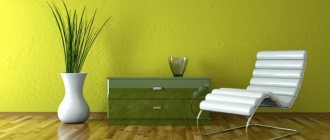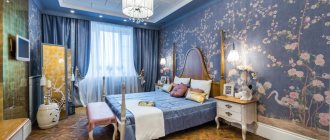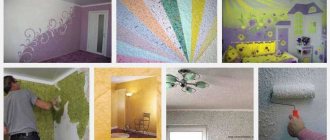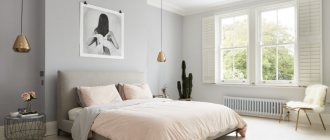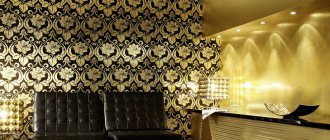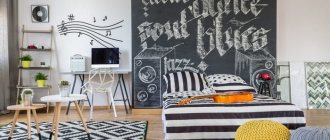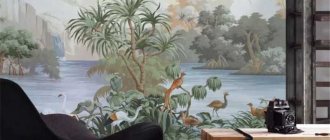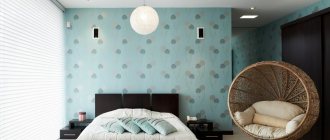Advantages of leather as a finishing material
This is a breathable material. This is additional thermal insulation, pleasant to the touch.
Air circulates through the pores, maintaining a light aroma in the apartment.
Leather wall coverings have the following advantages:
- sound insulation;
- thermal insulation;
- sophisticated look;
- reliability;
- long period of use guaranteed by the manufacturer;
- environmental friendliness;
- fire resistance enhanced by chemicals.
Advantages and variety of materials
Such walls look prestigious and expensive.
But you shouldn’t decorate the room entirely with leather wallpaper.
Leather as accessories
Today you can find a wide variety of leather accessories, for example, decorative leather baskets or lamps with shades covered in leather.
In addition, door and cabinet handles, as well as vases, ashtrays, curtains, blinds, etc. can be decorated with leather - all this gives the interior a special style. Currently, with the development of leather processing and dressing technologies, this material has generally become quite widely used. Leather can be used to cover not only furniture, but also household appliances, computers, telephones, etc., which allows you to turn an ordinary thing into a “living” one, as well as make it an exclusive item, and give the interior a special chic and warmth.
Question 3: how does decorative plaster imitate leather?
The plaster imitates the rough and textured skin of a snake or crocodile. Using tools, the master applies a pattern to the wall using the raw plaster mixture and draws out the scales. The finish looks impressive in black, green, orange tones. After 5 days of drying, the pattern on the wall becomes durable.
Options for imitation genuine leather
Plaster for leather products - decorates the wall, does not require additional decor. The type of pattern on the wall is chosen by the owners of the apartment.
Finishing is carried out with a mixture based on gypsum or acrylic.
To recreate the scales, rubber molds and decorative rollers are used. The effect of soft skin is achieved with film, paper and other devices.
Painting, varnishing, and glazing make the coating realistic. This is achieved by texture and smooth transition of tones. The range of shades is unlimited. This creates beautiful effects in individual areas.
Plaster
The finish can be applied regardless of the room. In small apartments, partial use of the coating looks more appropriate - application to one of the four walls, to place accents without overloading the room. These inserts play an important role in the perception of the interior.
Leather wall panels: types of wall decor
With the help of 3D leather panels, a variety of stylish interiors are created in the house. This could be a cozy corner in the bedroom or a safe area in a child's room. For all these interiors, wall decor made from eco-leather will be a practical and economical solution.
Leather wall panels are most often produced in square or rectangular shapes, and can have a variety of colors and surface designs. Made in a soft version, products for wall decoration made of eco-leather consist of three layers. For the base, a PVC board, plywood or hardboard can be used. The plastic base may sometimes have a self-adhesive layer. Thus, the manufacturer makes installation of its products simple and convenient.
Sintepon, foam rubber or polyurethane foam can be used as a filler that is fixed to the base.
Leather panels for walls filled with padding polyester will not deform or sag, since padding polyester is very light and it is not difficult to distribute it evenly over the surface.
Foam rubber is a denser filler, but it can be used to make wall decor more voluminous. It is recommended to decorate children's rooms with slabs filled with foam rubber. This finish can protect babies from injury.
Polyurethane foam is a relatively new filler, but has already proven itself on the positive side. It is non-flammable and completely safe for health. To its positive qualities we can add waterproofness, resistance to rotting, light weight and ease of handling. However, this filler is much stiffer than foam rubber and padding polyester.
In the case of smooth leather panels there is no filler. But this does not mean that smooth wall products are less decorative. They have a rich palette of shades. The surface of eco-leather is decorated with perforation and embossing. Patterns on the panels can range from simple florals to fantasy abstractions.
The base, with or without filler glued to it, is covered with eco-leather. Despite their low cost, leather wall panels with such upholstery look noble and impressive. They are often used not only in residential buildings and apartments, but also decorate bars, nightclubs and other public spaces with high traffic. The high strength and wear resistance of the panel surfaces make them a suitable finishing material for such establishments.
Soft leather panels are often decorated with carriage binding. This technique allows you to create different patterns. For 3D leather panels, perforated leather can be used. This option is suitable for cases where good air circulation is required.
Some manufacturers create leather wall panels with a self-adhesive backing. This option for wall decor is used in places where it is convenient to mount products without the use of glue. You can see all these wall decors, as well as soft panels, in our show room in Moscow “live” and on our website online in the online store catalog.
Leather panels for walls: characteristics
Eco-leather wall decors are very simple and easy to care for. However, to ensure a long service life, certain care rules must be followed:
· They must be wiped from dust with a soft, damp cloth;
· Do not use a brush that is too hard to care for leather panels;
· Traces of felt-tip pens are erased from the panels with soapy water;
· For stubborn stains, you should use special products for eco-leather;
· The use of bleaching and abrasive agents is prohibited.
If these rules are followed, leather products will last for many years. But durability is not the only advantage of this finishing decorative material.
All wall decors have thermal insulation and noise-absorbing characteristics to a greater or lesser extent. However, leather panels, especially in the soft version, are leaders in this indicator. That is why bars, karaoke clubs, and home theaters are often decorated with such panels.
Soft leather products make it easy to ensure safety in a child's room. The child will not be injured if he falls or collides with a wall.
Leather products are easy to repair if damaged. The damaged element is simply removed and replaced with a whole one.
Their installation is quite simple and does not require outside help. When installing on a lathing, there is no need to level and prepare the surface to be finished. However, it is still recommended to treat it with an anti-mold and mildew agent.
But more often they are simply glued to the wall using PVA glue or liquid nails. For this method, the walls will have to be plastered, leveled and primed. In the case of finishing the entire wall with leather panels, it is better to start work from the top row.
If they have a self-adhesive base, then their installation will involve peeling off the protective layer and firmly pressing the product against the wall.
Question 4: what to choose in the interior – leather or its imitation
A large selection of wallpaper requires a serious approach. The customer needs to take into account the interior of the room and imagine the final result.
Popular options:
- Imitation python skin. The scales of the relief are voluminous and uneven. Snake skin complements the design well and makes it unique. The walls go well with the marine theme in the interior.
- Zebra imitation. The decoration is in harmony with minimalism and monochrome. This area becomes the focal point of the room. Genuine leather wallpaper is combined with other animalistic wall elements in the loft style.
- Leopard imitation. Women like this option.
- Embossed leather. Gold or silver embossing is often used in production. Relevant for palace style designs. The wallpaper combines palace luxury and modernity.
Question No. 2. What are the available materials “under the skin”?
We are so used to gluing wallpaper in the room and tiles in the bathroom that we are amazed when we begin to wonder what other materials exist on the market. In addition to artificial leather, which can be used for upholstery of walls or ceilings, there are many options that are also more convenient to use: ready-made “leather” panels, panels, slabs, textured plasters and decorative coatings.
A “leather” texture can be obtained using the same wallpaper, but with a “leather-like” coating. Haven’t you heard about genuine leather floor tiles? A great material for a bedroom floor, by the way.
All these types of finishes have their advantages and disadvantages, but if we take the criteria of durability-aesthetics-price-versatility as a basis, then decorative plasters certainly come out on top.
Question 5: what to combine leather surfaces with
At first, designers used leather wallpaper to decorate foyers and restaurants. Now the material is used for finishing apartments and rooms in private houses. Popularity and convenience increase demand.
You can combine leather surfaces with any texture. The beauty is emphasized by natural wood, stone, glass, and metals.
The main condition is to avoid oversaturation. A lot of skin is bad form. Textiles, wood and other finishing materials should prevail in the interior. It is important to correctly emphasize, balance, and at the same time not drown out what you want to highlight.
Combination in interiors
Leather furniture
The most traditional design using leather in the interior of an apartment is the upholstery of various furniture items with this material. As a rule, these are the seats of chairs, sofas, beds, poufs, armchairs and stools. Such furniture always very effectively complements the interior (such as expensive laminate) and gives it special elegance and nobility.
Leather furniture in the interior
As for the color scheme, the most common are pastel wall colors, brown (especially the color of coffee beans) or black shades. The design with black and white combinations and the combination of yellow, red and beige tones look no less original.
At the same time, the style of an apartment or house can be absolutely anything, including very unexpected ones. Today, embroidery, crocodile leather or patterns on leather decorated with rhinestones, fur, metal or wooden elements, beads, etc. are very popular. Designer imagination is not limited here.
In addition, wall leather is often varnished, embossed or perforated. It can have stripes and braids with external seams, as well as to give a fashionable antique gloss. Faux leather furniture is often decorated with nails with large heads.
Coffee table made from a leather suitcase
Light leather sofa in the living room
Interior finishing options
You can partially cover a room with wallpaper. The decoration method depends only on the owners. It is advisable to combine leather with natural elements to give the room a noble look.
Panels or wallpaper are complemented with wood and clapboard. There are many options for implementing stylistic ideas.
Finishing methods
The method of working depends on the material. No surface preparation is required in any situation. It is enough that the walls are smooth, without large recesses and bulges. The tile is fixed with adhesive. The panels are attached to guides, the wallpaper is attached with glue for heavy materials.
What to pay attention to
Crocodile skin effect
There are rules that are followed when working with leather wallpaper. Violation of technology will lead to damage to the material and appearance of the wall.
To prevent the problem you need to follow the rules:
- Do not cover all walls. Full decoration is not a mistake, but designers advise making only part of the room leather. Balance the catchy finish with the remaining elements.
- Do not use prints, refuse to combine several types and patterns of leather-look wallpaper in one design. It is better to refrain from combining crocodile and snake prints. One option is enough.
- Do not use metal parts or varnished elements. This overloads the design.
- Refuse wallpaper in a frame or panel. Material is an independent element. Additional highlighting is a design mistake.
Soft decorative panels
A bright way to decorate. With soft panels you can focus attention on one wall, the head of the bed, or a niche.
Panels are a rigid base of a rectangular or square shape, which is covered with leather. With a soft insert inside, which makes them embossed. On top – natural or artificial leather. In addition to the main parts, manufacturers sell accessories - square, triangular, and narrow stripes. Expensive slabs are decorated with Swarovski stones. The panels are secured with polyurethane foam.
Leather three-dimensional wall tiles
Advantages of decorating with 3D panels:
- Exclusivity - the correct use of the material indicates good taste, the status of the owner, and his compliance with fashion. Decorating with 3D panels is not often found in apartments.
- Versatility - the panels are suitable for bedrooms, living rooms, hallways, children's rooms and kitchens. The scale of decoration can vary: more in the living room, less in the bedroom.
- Practicality - the durable coating can withstand heavy loads, it is easy to remove stains and marks from dirty hands.
- Soundproofing. The panels absorb noise well, which is important for a child’s room, bedroom, or home theater room.
- There is no need to make the walls smooth. The upholstery hides minor imperfections. You still can't do without basic alignment.
- Speed of work. The panels are quickly installed, without dust and dirt.
- Decorative. You can choose the upholstery method - leatherette, natural material or fabric. Select the shade and texture of the surface.
- Safe operation.
- Coziness, comfort. Soft panels make the room cozy and beautiful.
Of interest is the large selection of shades and textures, the possibility of obtaining the intended design. Decorative panels allow you to make repairs without hiring craftsmen.
Leather drapery, tight fitting
Finishing is also realized in other techniques - drapery and covering. When draping, soft surfaces are not obtained. Usually the material is simply glued to a flat surface.
Upholstering walls with leather makes it possible to obtain soft walls. They do it like this:
- Slats are attached to the walls, padding polyester and foam rubber are placed between them.
- The leather is nailed onto the top rail, its edge is folded in, then secured with a construction stapler.
- Afterwards, the material is stretched and nailed to the bottom and side slats.
- If the finishing area is small, then intermediate fastenings will not be needed.
The slats can be replaced with a profile equipped with clamps under the skin. This will make installation easier. The result will be a smoother wall, without folds.
Decorative leather panels for wall decoration
Decorating wall surfaces with leather panels is a very effective option for interior decoration of apartments, houses and cottages. However, the cost of decor made from genuine leather is high, and not everyone can afford it.
Modern technologies today make it possible to produce analogues of leather, which, at a relatively low price, do not compromise, and in some respects are superior to natural material.
Decorative wall panels made of eco-leather are used in the decoration of various rooms. They are highly durable, hygienic and meet all environmental standards. The wear resistance and durability of decor made from this material, as well as its affordable cost, make eco-leather products more preferable in creating the most sophisticated interiors.
Wall decors can be made in various colors and can be not only soft. Smooth wall versions of leather panels look no less impressive in decoration. The surface of eco-leather can be decorated with perforation or embossing with various patterns. Soft leather versions of the panels are often decorated with carriage screed or capitonné, which also comes in different forms. It can be square or diamond-shaped. Sometimes capitone is complemented with rhinestones.
Interiors created using leather panels have a unique look. Walls decorated with soft leather panels will add coziness to the bedroom; a living room with such decor will acquire severity and comfort. Leather panels for wall decoration, both soft and smooth, will be a worthy decoration for an office or home library. Even bathrooms and toilets can be finished with such panels.
Leather processing process
The process requires experience, attention and work skills. The use of expensive fabric requires professionalism; do not skimp on quality.
Installation of the quilted panel occurs in several stages:
- Firmware is marked on plywood or chipboard. The pattern is usually in a checkerboard pattern.
- Using a drill, holes are drilled in the places where the buttons are fastened.
- Foam rubber 5 cm thick is laid and fixed to the base with glue.
- The markings are transferred to the foam rubber.
- A padding polyester is laid and glued to the foam rubber.
- In places for buttons, holes are cut with scissors.
- Leather or substitute is placed on top of the padding polyester, leveled, and glued.
- The holes are located by touch, then the button is fixed with a long hook and the rope is tightened.
- The cord is pulled to the wrong side and secured with a construction stapler.
- After finishing the work, the edges of the upholstery are also fixed with a stapler from the wrong side.
Leather tiles: versatility, practicality, aesthetics
Leather tiles are used in almost all areas - to decorate walls, ceilings, floors, and furniture. This could be a small panel, an accent wall, a covering on a door, staircase, or bar counter. No matter where the tile is used, the leather looks amazing. The appearance of the material is complemented by the impressive performance characteristics of the finish, which adds to its popularity. There are two main types of leather tiles available.
Wall-mounted
Designed for finishing walls and interior elements, it is also used for ceilings. Most manufacturers offer tiles consisting of three layers - a cellulose base (thick cardboard) or fiberboard (chipboard), a volumetric lining (foam rubber), and a decorative leather layer. The raw material for wall tiles is almost any leather - from veal to crocodile and snake. There are also many textures and surfaces: tiles can be smooth and patterned, flat and voluminous, natural shades and bright, fancy colors.
The Dutch company, one of the first to master the production of finishing leather tiles, offers a unique technology - using a laser, segments of any shape and size of the required thickness are cut from buffalo leather. No base or foam backing is used, only genuine leather with laser perforation, decorative edge trim, and stitching.
Leather wall tiles can be used in any operating conditions - there are collections specifically for wet rooms. A special coating protects the surface from external influences, so the leather in the bathroom, swimming pool or kitchen will not only look beautiful, but also serve well without losing its visual appeal.
Manufacturers offer a large selection of shapes and sizes, but the bulk of brands are represented by several standard categories of tiles:
- Square – 20×20 cm, 30×30 cm, 40×40 cm, 50×50;
- Rectangular – 30×45 cm;
- Hexagonal – edges 20 cm and 23 cm;
- Octagonal - sides 20 cm, plus connecting square tiles with a side of 8 cm;
- Wavy – 30×14 cm.
This variety allows you to lay out various panels, combining tiles of several sizes. It is possible to produce the material according to the customer’s patterns and apply the desired patterns to the surface.
Floor
Increased demands are placed on floor coverings, so the tiles are mainly made from bovine leather from the middle part of the carcass - saddle cloth. It is characterized by increased strength, wear resistance and thickness - at least 3 mm. Porcelain stoneware is used as the basis for the floor variety, and the leather is treated with a tanning compound that increases strength. Thanks to the base and processing, the service life of leather floor tiles varies between 15–20 years, which is comparable to other finishing materials.
Leather floor tiles come in two types:
- Square – 45×45 cm or 60×60 cm;
- Rectangular – 60×30 cm.
The choice of colors is somewhat poorer than that of wall material - about 10 options, mostly smooth texture.
Interior design features
Here are some rules you need to know to get the most successful decor in your room:
- The floor and ceiling should preferably be combined in color with the print on the wallpaper; it is better to use plain, non-shiny textures.
- Contrasting combinations will also not fit particularly harmoniously into the interior of the room. For example, if you opted for a dark reptile-skin wall covering, and the other finishing was done in rich red, then you will get tired of it very quickly.
- Using two different prints in one room is also considered a rather unfortunate decision.
Expert advice
- Another way to decorate a wall is to create a suede effect. When preparing the surface, it should be made smooth and dust-free. It is also important to take care of dry walls. Any unevenness is removed, as is old paint, plaster or wallpaper.
Before you start decorating the wall with suede, you should create a base of primer paint. The material is applied in two layers using a spray gun or roller. It is necessary to wait up to 8 hours between layers. The final period will depend on the level of humidity and temperature in the room.
As soon as the second layer has dried, you should go over it with sandpaper. Now you can begin applying the first layer of plaster using a trowel and spatula. The second layer is applied using the same principle after the first has dried.
To create a more visible texture, you should, without waiting for it to dry, walk over the surface with a trowel, trying to create the effect of a suede cloth using multidirectional movements. It is the strokes that will determine the similarity with natural material. The resulting suede coating will be durable and moisture resistant. The wall can even be washed with water. Suede-effect material is environmentally friendly.
- To create the effect of wrinkled leather, you can use a roller on which plastic film is wound. When the decorative plaster is evenly distributed over the wall using metal grout, you should begin to create the effect by running the roller from top to bottom.
In this state, the layer is left for a day, and the dry wall is painted with a brush and roller. The application of paint can only be superficial if the base layer of plaster is of a suitable color. The protruding relief is removed after painting using a spatula.
Attention! The effect of wrinkled skin can also be achieved using tracing paper. But the technique in this case will be more complex, and the result will be high.
Price issue
Natural leather tiles, with all its advantages, have a significant drawback - it is a luxury material that not everyone can afford. Domestic wall tiles in Moscow cost about four thousand rubles per square meter, imported ones are much more expensive. Floor, due to the special raw materials and complex production process, costs from twelve thousand per square. The cheapest collection of Dutch exclusives is Vintage, estimated at 190 euros per tile of standard sizes - 30x30 cm or 30x60 cm. If the sizes are individual, the price rises to 220 euros.
When there is no financial opportunity to completely decorate the walls, but you want leather luxury and exclusivity, you can buy several squares and lay out a drawing or panel, placing an emphasis on the wall or highlighting a seating area on the floor. Even a small covering of genuine leather will transform the interior, so that the wallet will not suffer much, and the soul that asked for royal chic will be satisfied. But even in this case, you will have to shell out a substantial amount. To save as much as possible on finishing, you can make the tiles yourself; fortunately, specialized stores have a large selection of materials and consumables.
One of the options for organizing a base layer for leather floor tiles is discussed in the article “Dry screed...”. And for those who are faced with the problem of noisy neighbors - material on soundproofing the ceiling. A video about the interaction between customers and performers will help you find craftsmen who can work with such an unusual material as leather tiles.
Subscribe to our Telegram channelExclusive posts every week
